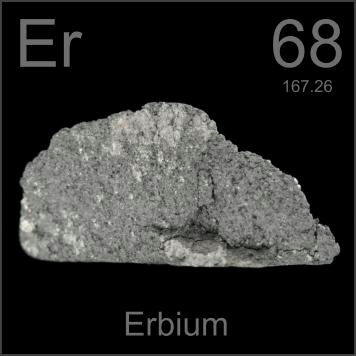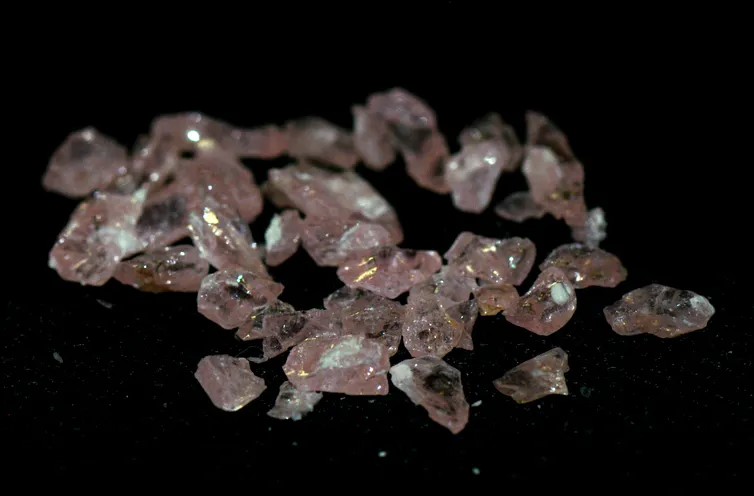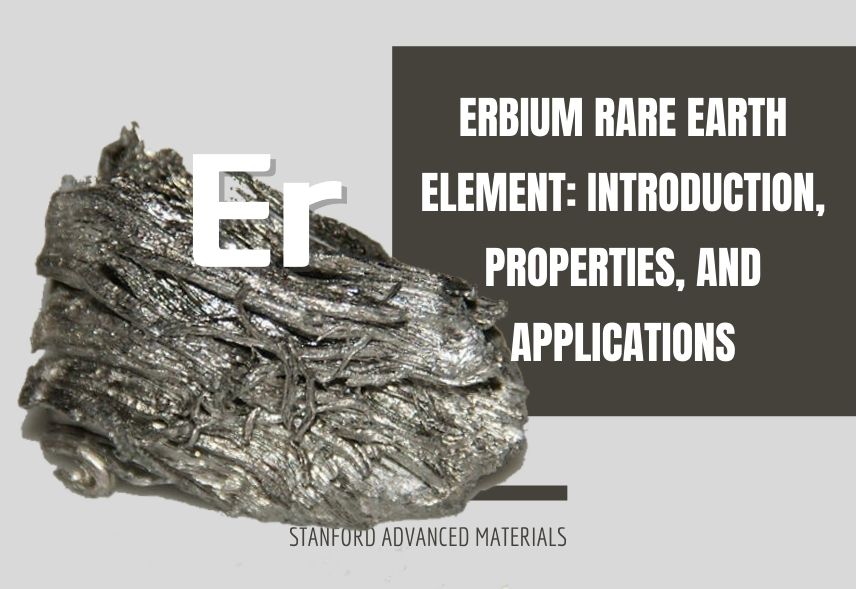Introduction
Erbium is one of the 17 rare-earth elements. This means it also belongs to the lanthanide series. Its atomic number is 68, and its symbol is Er. When one is told that Erbium is a rare-earth metal, one might expect it to be challenging to come across. However, Erbium ranks number 45 in the list of the most abundant elements on Earth.
This element is most abundant in a town called Ytterby, located in Sweden. Erbium gets its name from this small town. A Swedish surgeon known as Carl-Gustav Mosander discovered Erbium in 1843. He discovered Erbium as a compound known as Erbia. It was not until 1934 that two German workers, Wilhelm Klemm and Heinrich Bommer, isolated Erbium in its pure form.

Erbium has 6 stable isotopes. The most abundant of these isotopes is 166 Er, while the least abundant is 162 Er. 166 Er makes up 33.5% of naturally occurring Erbium, while 162 Er makes up 0.14%. The remaining 66.36% is shared between the other four isotopes (164 Er, 167 Er, 168 Er, and 170 Er). In addition to the six naturally occurring isotopes, it has 29 radioisotopes.
Further Reading: Metal Encyclopedia: Seventeen Rare Earth Elements Introduction
Properties
Erbium is a rare-earth element. Therefore, it has properties similar to other rare-earth elements. However, it also has some properties that make it different from other rare-earth elements.
Erbium has a hexagonal, and closely packed lattice system, is relatively soft, and has about 29 radioisotopes. Its standard atomic weight is 167.259.
Most properties of erbium are due to its atomic number and periodicity. On the periodic table, it belongs to period 6, f-block. It is solid at room temperature. Its melting point is 1802 K, and its boiling point is 3141 K.
Erbium’s density varies with its state. When it is solid, its density is 9.07g/cm3, but when it is liquid, it becomes 8.86g/cm3.
Erbium undergoes several chemical reactions. It tarnishes slowly in a humid atmosphere and is highly reactive with all halogens to form compounds with colors ranging from pink to violet. It is soluble in dilute sulfuric acid and combusts to form erbium(iii)oxide. On reacting with cold or hot water, it forms erbium hydroxide. Its reaction with the latter is fast, while its reaction with the latter is slow.
In addition, Erbium has a very high magnetic strength. It is ferromagnetic under 19K, antiferromagnetic between 19 and 79K, and paramagnetic at about 80K. It has a silvery appearance, but its salts have a pinkish color that makes them attractive.
Application
Like other rare-earth metals, Erbium is usually used as an alloy or compound. It is rarely used in its isolated form. What are some of the uses of Erbium in the world today, and which of its properties are responsible for its uses?
Dentistry
Erbium produces laser energy that can be used in a dental procedure called laser enamel ablation. This is the removal of the enamel of a tooth with laser energy.
Surgery
Erbium is vital for laser surgeries because it produces laser energy that can be used to cut through tissue, as is the case in laser surgeries. The laser replaces a scalpel. Laser surgeries can be used to remove scars and moles. Laser surgeries can also be used to treat eye defects.
Cancer
Erbium can be used for tumor ablation. Tumor ablation is a treatment procedure for cancer using laser energy.
Thin-Film Coating
Erbium sputtering targets and erbium evaporation materials are used in deposition processes including semiconductor deposition, chemical vapor deposition (CVD) and physical vapor deposition (PVD).
Catalyst
Erbium chloride can be used as a catalyst. It catalyzes reactions that form alkanols and phenols.
Water Treatment
Erbium bromide is a water-soluble compound. It can be used to treat water.
Optical Communication
Erbium compounds are used for optical communication. Optical communication involves the use of light to carry information along far distances. Optical fibers, lasers, and routers are frequently used for optical communication, and they can be made from erbium compounds.
Alloy
Erbium is combined with different metals to improve their quality. For example, it is mixed with vanadium to make vanadium more malleable. It is also added to nickel to raise its specific heat capacity.
Colorant
Erbium salts have a pink color. These salts can be used to add color to glass, porcelain, and other materials. When these materials are colored, it improves their aesthetics and allows them to be used in making jewelry, windows, dinner sets, and mirrors.

Control Rods
Erbium compounds are used in the manufacture of control rods, which are used in nuclear reactors.
Precaution
When dealing with Erbium, you want to note the following:
- When taken orally, pure erbium can be toxic.
- The element is highly combustible, and its dust particles can trigger a fire outbreak.
Conclusion
Erbium is a relatively abundant rare-earth metal. It is a crucial element in modern-day technology. Many industries worldwide use Erbium daily for many important processes and products due to its versatility. If you want to know more about rare earth elements, we would like to advise you to visit Stanford Advanced Materials (SAM) for more information.





